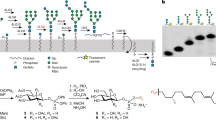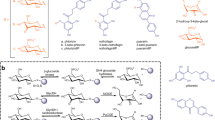Abstract
Asparagine-linked glycosylation is a complex protein modification conserved among all three domains of life. Herein we report the in vitro analysis of N-linked glycosylation from the methanogenic archaeon Methanococcus voltae. Using a suite of synthetic and semisynthetic substrates, we show that AglK initiates N-linked glycosylation in M. voltae through the formation of α-linked dolichyl monophosphate N-acetylglucosamine, which contrasts with the polyprenyl diphosphate intermediates that feature in both eukaryotes and bacteria. Notably, AglK has high sequence homology to dolichyl phosphate β-glucosyltransferases, including Alg5 in eukaryotes, suggesting a common evolutionary origin. The combined action of the first two enzymes, AglK and AglC, afforded an α-linked dolichyl monophosphate glycan that serves as a competent substrate for the archaeal oligosaccharyl transferase AglB. These studies provide what is to our knowledge the first biochemical evidence revealing that, despite the apparent similarity of the overall pathways, there are actually two general strategies to achieve N-linked glycoproteins across the domains of life.
This is a preview of subscription content, access via your institution
Access options
Subscribe to this journal
Receive 12 print issues and online access
$259.00 per year
only $21.58 per issue
Buy this article
- Purchase on Springer Link
- Instant access to full article PDF
Prices may be subject to local taxes which are calculated during checkout





Similar content being viewed by others
References
Nothaft, H. & Szymanski, C.M. Protein glycosylation in bacteria: sweeter than ever. Nat. Rev. Microbiol. 8, 765–778 (2010).
Eichler, J. Extreme sweetness: protein glycosylation in archaea. Nat. Rev. Microbiol. 11, 151–156 (2013).
Larkin, A. & Imperiali, B. The expanding horizons of asparagine-linked glycosylation. Biochemistry 50, 4411–4426 (2011).
Szymanski, C.M., Yao, R., Ewing, C.P., Trust, T.J. & Guerry, P. Evidence for a system of general protein glycosylation in Campylobacter jejuni. Mol. Microbiol. 32, 1022–1030 (1999).
Magidovich, H. & Eichler, J. Glycosyltransferases and oligosaccharyltransferases in archaea: putative components of the N-glycosylation pathway in the third domain of life. FEMS Microbiol. Lett. 300, 122–130 (2009).
Chaban, B., Voisin, S., Kelly, J., Logan, S.M. & Jarrell, K.F. Identification of genes involved in the biosynthesis and attachment of Methanococcus voltae N-linked glycans: insight into N-linked glycosylation pathways in archaea. Mol. Microbiol. 61, 259–268 (2006).
Abu-Qarn, M. & Eichler, J. Protein N-glycosylation in archaea: defining Haloferax volcanii genes involved in S-layer glycoprotein glycosylation. Mol. Microbiol. 61, 511–525 (2006).
Mescher, M.F. & Strominger, J.L. Purification and characterization of a prokaryotic glucoprotein from the cell envelope of Halobacterium salinarium. J. Biol. Chem. 251, 2005–2014 (1976).
Mescher, M.F., Hansen, U. & Strominger, J.L. Formation of lipid-linked sugar compounds in Halobacterium salinarium. Presumed intermediates in glycoprotein synthesis. J. Biol. Chem. 251, 7289–7294 (1976).
Lechner, J., Wieland, F. & Sumper, M. Biosynthesis of sulfated saccharides N-glycosidically linked to the protein via glucose. Purification and identification of sulfated dolichyl monophosphoryl tetrasaccharides from halobacteria. J. Biol. Chem. 260, 860–866 (1985).
Burda, P. & Aebi, M. The dolichol pathway of N-linked glycosylation. Biochim. Biophys. Acta 1426, 239–257 (1999).
Calo, D., Guan, Z., Naparstek, S. & Eichler, J. Different routes to the same ending: comparing the N-glycosylaton processes of Haloferax volcanii and Haloarcula morismortui, two halophilic archaea from the Dead Sea. Mol. Microbiol. 81, 1166–1177 (2011).
Kuntz, C., Sonnenbichler, J., Sonnenbichler, I., Sumper, M. & Zeitler, R. Isolation and characterization of dolichol-linked oligosaccharides from Haloferax volcanii. Glycobiology 7, 897–904 (1997).
Guan, Z. et al. Distinct glycan-charged phosphodolichol carriers are required for the assembly of the pentasaccharide N-linked to the Haloferax volcanii S-layer glycoprotein. Mol. Microbiol. 78, 1294–1303 (2010).
Guan, Z., Meyer, B., Albers, S.-V. & Eichler, J. The thermoacidophilic archaeaon Sulfolobus acidocaldarius contains an unusually short, highly reduced dolichol phosphate. Biochim. Biophys. Acta 1811, 607–616 (2011).
Yurist-Doutsch, S., Chaban, B., VanDyke, D.J., Jarrell, K.F. & Eichler, J. Sweet to the extreme: protein glycosylation in archaea. Mol. Microbiol. 68, 1079–1084 (2008).
VanDyke, D.J. et al. Identification of genes involves in the assembly and attachment of a novel flagellin N-linked tetrasaccharide important for motility in the archaeon Methanococcus maripaludis. Mol. Microbiol. 72, 633–644 (2009).
Voisin, S. et al. Identification and characterization of the unique N-linked glycan common to the flagellins and S-layer glycoprotein of Methanococcus voltae. J. Biol. Chem. 280, 16586–16593 (2005).
Chaban, B., Logan, S.M., Kelly, J.F. & Jarrell, K.F. AglC and AglK are involved in biosynthesis and attachment of diacetylated glucuronic acid to the N-glycan in Methanococcus voltae. J. Bacteriol. 191, 187–195 (2009).
Shams-Eldin, H., Chaban, B., Niehus, S., Schwarz, R.T. & Jarrell, K.F. Identification of the archaeal alg7 gene homolog (encoding N-acetylglucosamine-1-phosphate transferase) of the N-linked glycosylation system by cross-domain complementation in Saccharomyces cerevisiae. J. Bacteriol. 190, 2217–2220 (2008).
Jones, M.B., Rosenburg, J.N., Betenbaugh, M.J. & Krag, S.S. Structure and synthesis of polyisoprenoids used in N-glycosylation across the three domains of life. Biochim. Biophys. Acta 1790, 485–494 (2009).
Naparstek, S., Guan, Z. & Eichler, J. A predicted geranylgeranyl reductase reduces the ω-position isoprene of dolichol phosphate in the halophilic archaeon, Haloferax volcanii. Biochim. Biophys. Acta 1821, 923–933 (2012).
Heesen, S., Lehle, L., Weissmann, A. & Aebi, M. Isolation of the ALG5 locus encoding the UDP-glucose:dolichyl-phosphate glucosyltransferase from Saccharomyces cerevisiae. Eur. J. Biochem. 224, 71–79 (1994).
Kaminski, L. et al. AglJ adds the first sugar of the N-linked pentasaccharide decorating the Haloferax volcanii S-layer glycoprotein. J. Bacteriol. 192, 5572–5579 (2010).
Krogh, A., Larsson, B., von Heijne, G. & Sonnhammer, E.L. Predicting transmembrane protein topology with a hidden Markov model: application to complete genomes. J. Mol. Biol. 305, 567–580 (2001).
Hartley, M.D. & Imperiali, B. At the membrane frontier: a prospectus on the remarkable evolutionary conservation of polyprenols and polyprenyl-phosphates. Arch. Biochem. Biophys. 517, 83–97 (2012).
Kelly, J., Logan, S.M., Jarrell, K.F., VanDyke, D.J. & Vinogradov, E.V. A novel N-linked flagellar glycan from Methanococcus maripaludis. Carbohydr. Res. 344, 648–653 (2009).
Behrens, N.H. & Leloir, L.F. Dolichyl monophosphate glucose: an intermediate in glucose transfer in liver. Proc. Natl. Acad. Sci. USA 66, 153–159 (1970).
Tkacz, J.S., Herscovics, A., Warren, C.D. & Jeanloz, R.W. Mannosyltransferase activity in calf pancreas microsomes. Formation from guanosine diphosphate-D-[14C]mannose of a 14C-labeled mannolipid with properties of dolichyl mannopyranosyl phosphate. J. Biol. Chem. 249, 6372–6381 (1974).
Herscovics, A., Warren, C.D. & Jeanloz, R.W. Anomeric configuration of the dolichyl-D-mannosyl phosphate formed in calf pancreas microsomes. J. Biol. Chem. 250, 8079–8084 (1975).
O'Connor, J.V., Nunez, H.A. & Barker, R. α- and β-glycopyranosyl phosphates and 1,2-phosphates. Assignments of conformations in solution by 13C and 1H NMR. Biochemistry 18, 500–507 (1979).
Larkin, A. & Imperiali, B. Biosynthesis of UDP-GlcNAc(3NAc)A by WbpB, WbpE, and WbpD: enzymes in the Wbp pathway responsible for O-antigen assembly in Pseudomonas aeruginosa PAO1. Biochemistry 48, 5446–5455 (2009).
Sharma, C.B., Lehle, L. & Tanner, W. N-Glycosylation of yeast proteins. Characterization of the solubilized oligosaccharyl transferase. Eur. J. Biochem. 116, 101–108 (1981).
Imperiali, B. & Hendrickson, T.L. Asparagine-linked glycosylation: specificity and function of oligosaccharyl transferase. Bioorg. Med. Chem. 3, 1565–1578 (1995).
Glover, K.J., Weerapana, E., Numao, S. & Imperiali, B. Chemoenzymatic synthesis of glycopeptides with PglB, a bacterial oligosaccharyl transferase from Campylobacter jejuni. Chem. Biol. 12, 1311–1315 (2005).
Jaffee, M.B. & Imperiali, B. Exploiting topological constraints to reveal buried sequence motifs in the membrane-bound N-linked oligosaccharyl transferases. Biochemistry 50, 7557–7567 (2011).
Lizak, C., Gerber, S., Numao, S., Aebi, M. & Locher, K.P. X-ray structure of a bacterial oligosaccharyltransferase. Nature 474, 350–355 (2011).
Ferrante, G., Ekiel, I. & Sprott, G.D. Structural characterization of the lipids of Methanococcus voltae, including a novel N-acetylglucosamine 1-phosphate diether. J. Biol. Chem. 261, 17062–17066 (1986).
Charnock, S.J. & Davies, G.J. Structural analysis of the nucleotide-diphospho-sugar transferase, SpsA from Bacillus subtilis, in native and nucleotide-complexed forms. Biochemistry 38, 6380–6385 (1999).
Coutinho, P.M., Deleury, E., Davies, G.J. & Henrissat, B. An evolving hierarchical family classification for glycosyltransferases. J. Mol. Biol. 328, 307–317 (2003).
Lairson, L.L., Henrissat, B., Davies, G.J. & Withers, S.G. Glycosyltransferases: structures, functions, and mechanisms. Annu. Rev. Biochem. 77, 521–555 (2008).
Flint, J. et al. Structural dissection and high-throughput screening of mannosylglycerate synthase. Nat. Struct. Mol. Biol. 12, 608–614 (2005).
Ramirez, F. & Marecek, J.F. Coordination of magnesium with adenosine 5′-diphosphate and triphosphate. Biochim. Biophys. Acta 589, 21–29 (1980).
Igura, M. et al. Structure-guided identification of a new catalytic motif of oligosaccharyltransferase. EMBO J. 27, 234–243 (2008).
Matsumoto, S. et al. Crystal structure of the C-terminal globular domain of oligosaccharyltransferase from Archaeoglobus fulgidus at 1.75 Å resolution. Biochemistry 51, 4157–4166 (2012).
Świeżewska, E. et al. The search for plant polyprenols. Acta Biochim. Pol. 41, 221–260 (1994).
Wu, R., Beauchamps, M.G., Laquidara, J.M. & Sowa, J.R. Jr. Ruthenium-catalyzed asymmetric transfer hydrogenation of allylic alcohols by an enantioselective isomerization/transfer hydrogenation mechanism. Angew. Chem. Int. Ed. Engl. 51, 2106–2110 (2012).
Suzuki, S. et al. Synthesis of mammalian dolichols from plant polyprenols. Tetrahedr. Lett. 24, 5103–5106 (1983).
Branch, C.L., Burton, G. & Moss, S.F. An expedient synthesis of allylic polyprenol phosphates. Synth. Commun. 29, 2639–2644 (1999).
Imperiali, B. & Zimmerman, J.W. Synthesis of dolichylpyrophosphate-linked oligosaccharides. Tetrahedr. Lett. 31, 6485–6488 (1990).
Tai, V.W.F. & Imperiali, B. Substrate specificity of the glycosyl donor for oligosaccharyl transferase. J. Org. Chem. 66, 6217–6228 (2001).
Sim, M.M., Kondo, H. & Wong, C.-H. Synthesis and use of glycosyl phosphites: an effective route to glycosyl phosphates, sugar nucleotides, and glycosides. J. Am. Chem. Soc. 115, 2260–2267 (1993).
Folch, J., Lees, M. & Stanley, G.H.S. A simple method for the isolation and purification of total lipids from animal tissues. J. Biol. Chem. 226, 497–509 (1957).
Troutman, J.M. & Imperiali, B. Campylobacter jejuni PglH is a single active site processive polymerase that utilizes product inhibition to limit sequential glycosyl transfer reactions. Biochemistry 48, 2807–2816 (2009).
Acknowledgements
This work was supported by a grant from the US National Institutes of Health (GM039334 to B.I.) The authors are grateful to M. Jaffee for help with initial expression studies, J. Simpson (Department of Chemistry Instrumentation Facility, Massachusetts Institute of Technology) for assistance with NMR acquisition, W. Whitman (University of Georgia) for the gift of both M. voltae genomic DNA and M. maripaludis cell pellets and E. Swiezewska (Polish Academy of Sciences) for providing a sample of racemic short dolichols for preliminary studies.
Author information
Authors and Affiliations
Contributions
B.I., A.L., M.M.C. and G.E.W. designed the experiments. A.L., M.M.C. and G.E.W. performed the experiments. The manuscript was written through the contributions of all of the authors.
Corresponding author
Ethics declarations
Competing interests
The authors declare no competing financial interests.
Supplementary information
Supplementary Text and Figures
Supplementary Results (PDF 8126 kb)
Rights and permissions
About this article
Cite this article
Larkin, A., Chang, M., Whitworth, G. et al. Biochemical evidence for an alternate pathway in N-linked glycoprotein biosynthesis. Nat Chem Biol 9, 367–373 (2013). https://doi.org/10.1038/nchembio.1249
Received:
Accepted:
Published:
Issue Date:
DOI: https://doi.org/10.1038/nchembio.1249
This article is cited by
-
Discovery of a biomarker candidate for surgical stratification in high-grade serous ovarian cancer
British Journal of Cancer (2021)
-
The structure of an archaeal oligosaccharyltransferase provides insight into the strict exclusion of proline from the N-glycosylation sequon
Communications Biology (2021)
-
AglH, a thermophilic UDP-N-acetylglucosamine-1-phosphate:dolichyl phosphate GlcNAc-1-phosphotransferase initiating protein N-glycosylation pathway in Sulfolobus acidocaldarius, is capable of complementing the eukaryal Alg7
Extremophiles (2017)
-
The multiple evolutionary origins of the eukaryotic N-glycosylation pathway
Biology Direct (2016)
-
Engineered oligosaccharyltransferases with greatly relaxed acceptor-site specificity
Nature Chemical Biology (2014)



